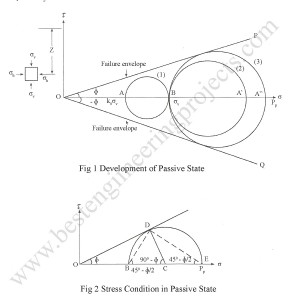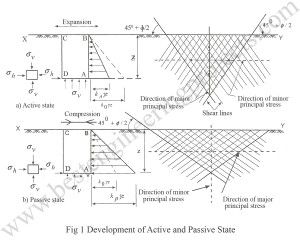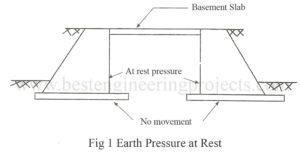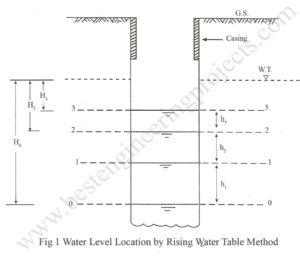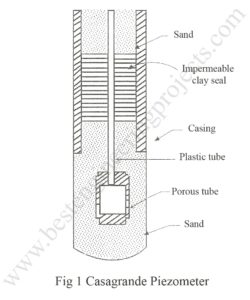What are the Effect of Sloping Surcharge in Active Case? in this article we will discuss about Effect of Sloping Surcharge in Active Case. A wall carrying a sloping backfill is shown in Fig.1. Consider an element subjected to a stress in the vertical direction and in the direction parallel to the backfill. As these stresses in one plane are parallel to the direction of another plane, these stresses are conjugate stresses and the planes are the conjugate planes. The equivalent vertical stress acting parallel to the surface of backfill is…
Read MoreActive Earth Pressure for Partially submerged Sand with Surcharge
What is Active Earth Pressure for Partially submerged Sand with Surcharge? In Figure 1 active earth pressure for partially submerged sand and surcharge is shown. The height of the wall is Z and the position of the water table is at a depth of Z1 and the surcharge acting at the top of horizontal surface of the wall is q. The height of the wall below water table is Z2. The unit weight of the sand above water table is and that below water table is . CASE 1 | Active Earth…
Read MoreMohr Circle | Mohr Circle For Passive Earth Pressure
In this article we will discuss about mohr circle for passive earth pressure, figure 1 below shows the state of stresses on the base and the side of the prism CA at depth Z in a Mohr circle. The vertical stress is the principal stress. OP and OQ are the two Mohr envelopes satisfying the Coulomb’s equation of shear strength. Initially the stresses and are the major and minor principal stress. The points A and B in mohr circle for passive earth pressure diagram respectively denote these stresses at rest condition.…
Read MoreMohr Circle | Mohr Circle For Active Earth Pressure
IN this article we will discuss about Mohr Circle for active earth pressure. Figure 1 below shows the state of stresses on the base and the side of the prism CA at depth z in a Mohr circle. The vertical stress is the principal stress. OP and OQ are the two Mohr envelopes satisfying the Coulomb’s equation of shear strength. Initially the stresses and are the major and minor principal stresses. The points A and B in the Mohr Circle for active earth pressure diagram respectively denote these stresses at…
Read MoreRankine’s Earth Pressure Theory | Classic Earth Pressure Theory
W. J. Rankine in 1857 published his theory of lateral earth pressure from a different approach. Rankine’s earth pressure theories provide the magnitude, direction, and point of application of active and passive earth pressures acting on a retaining wall. These theories are known as classical earth pressure theories. Rankine’s made the following assumptions while deriving his earth pressure theory. The assumptions are: The soil mass is homogeneous and semi-infinite. The back of the retaining wall is vertical. The back of the Wall is smooth. The wall movement is sufficient so…
Read MoreEarth Pressure at Rest | Coefficient Earth Pressure at Rest
When a soil mass gets deposited naturally or artificially, the coefficient of earth pressure attains a value known as coefficient of earth pressure at rest (K0) which is intermediate between coefficient of active earth pressure (Ka) and coefficient of passive earth pressure (Kp) values. In this case the horizontal stress is given by, —————————–(1) Where, = Vertical Stress at depth ‘z’ = Unit weight of soil z = Depth below ground surface The value of K0 depends upon the relative density of sand, and the process by which the process…
Read MoreYield | Relation Between Yield and Magnitude of Earth Pressure
The amount of movement is called yield. The relation between yield and magnitude of earth pressure is illustrated in Fig.1. As the earth pressure largely depends upon the flexibility of the wall, the earth pressure problem is a case of soil structure interaction. The soil in the region beyond the active and passive state of failure will be in plastic state while the soil in the region within the active and passive state will be in the elastic state. Such failure of a soil mass is called the state of plastic…
Read MoreEarth Pressure | Active Earth Pressure | Passive Earth Pressure
Any material will be stable at a certain slope angle. If the slope angle is greater than its safe Value, the slope will be unstable and soils/rocks located at higher elevation tend to move downwards and outwards. In such cases in order to maintain the stability of soil a retaining structure is to be provided. The soil mass behind a retaining wall, in most of the cases retains soil mass, which are vertical or nearly vertical. The purpose of the retaining structure is to maintain soils located at different locations.…
Read MoreHvorslev Method for Water Table Location
Introduction to Hvorslev Method for Water Table Location As per the Hvorslev Method for Water Table Location, water table level can also be located in a borehole used for soil investigation. That type of bore hole should have a casing to stabilize the sides. It uses almost the same technique, the rise in water level determines the water level locations. However, there is a slight difference. Unlike Casagrande piezometer method, this method consists of hailing the water out of the casing and observing the rate of rise of the water level…
Read MoreCasagrande Method for Ground Water Observation
Here in this article we will discuss about Casagrande Method for Ground Water Observation. From the foundation design and construction point of view, it is fundamental to have reliable information about the ground water level which lies within the zone of influence of a foundation to be settled. For this, the simplest way to gain information is to observe the nearby ground water table in open wells when they are available. We can find out the ground water table from boreholes. As we advance the borehole through drilling process, after…
Read More

